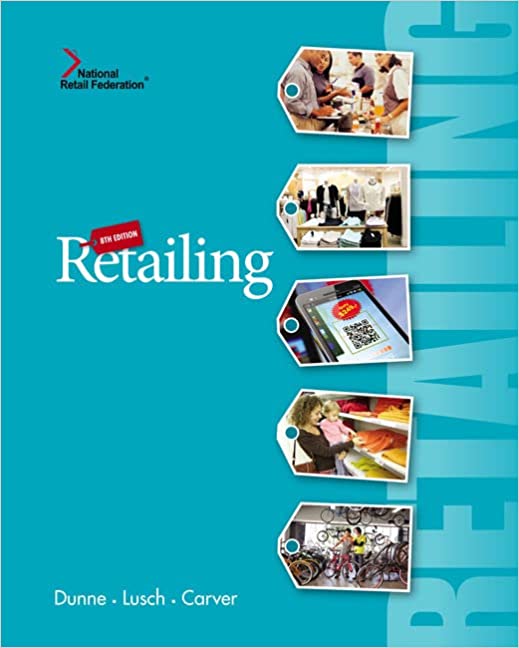
Retailing 8th Edition by Patrick Dunne,Robert Lusch, James Carver
Edition 8ISBN: 978-1133953807
Retailing 8th Edition by Patrick Dunne,Robert Lusch, James Carver
Edition 8ISBN: 978-1133953807 Exercise 7
Diva's is a 55-store upscale women's shoe chain targeting businesswomen and college students. Most of its stores are located in regional malls in the Southeast and Southwest. The chain has enjoyed rapid growth over the last decade, and its annual sales volume last year was $180 million with a 6.1 percent net profit margin (before taxes).
Diva's prices most of its shoes between $39.95 and $119.95. The top-selling shoes are sold using the chain's private label, Avalanche. A primary reason for the success of Diva's has been its vertical marketing channel. The chain has eliminated most suppliers and relies almost entirely on contracting with small manufacturers to make shoes.
Diva's staff designs most of the shoes and has them made to specification by manufacturers in Mexico. As a result Diva is able to operate on a gross margin of 45 percent that is considerably higher than its competitors who do not direct source and use contract manufacturing.
As a result, the chain's shoes are priced approximately 20 percent lower than competitors' shoes of a similar quality. In addition, the chain has a higher markup than stores that buy from manufacturers and wholesalers. Besides these advantages, vertical integration minimizes potential sources of conflict.
This strategy does have its weaknesses, though. Diva's needs a large amount of capital. Money is needed to purchase raw materials and to defray other costs incurred during manufacture. Since Diva needs to supply these raw materials, its total inventory includes raw materials, semi-finished goods, and finished goods and averages $60 million. In addition, since orders are placed approximately nine months to a year in advance of shoe sales, predicting sales is difficult. If orders are placed with manufacturers and business slows down, orders cannot be reduced or canceled. Finally, slow-moving merchandise cannot be returned to vendors. If something does not sell, it has to be marked down in hopes that it will.
Using this strategy, how would the retailer's need for capital affect its return on assets (ROA) during an economic slowdown (The student might want to refer to the strategic profit model discussed in Chapter 2.) In view of your answer, should the chain change its merchandise mix by adding well-known national brands
Diva's prices most of its shoes between $39.95 and $119.95. The top-selling shoes are sold using the chain's private label, Avalanche. A primary reason for the success of Diva's has been its vertical marketing channel. The chain has eliminated most suppliers and relies almost entirely on contracting with small manufacturers to make shoes.
Diva's staff designs most of the shoes and has them made to specification by manufacturers in Mexico. As a result Diva is able to operate on a gross margin of 45 percent that is considerably higher than its competitors who do not direct source and use contract manufacturing.
As a result, the chain's shoes are priced approximately 20 percent lower than competitors' shoes of a similar quality. In addition, the chain has a higher markup than stores that buy from manufacturers and wholesalers. Besides these advantages, vertical integration minimizes potential sources of conflict.
This strategy does have its weaknesses, though. Diva's needs a large amount of capital. Money is needed to purchase raw materials and to defray other costs incurred during manufacture. Since Diva needs to supply these raw materials, its total inventory includes raw materials, semi-finished goods, and finished goods and averages $60 million. In addition, since orders are placed approximately nine months to a year in advance of shoe sales, predicting sales is difficult. If orders are placed with manufacturers and business slows down, orders cannot be reduced or canceled. Finally, slow-moving merchandise cannot be returned to vendors. If something does not sell, it has to be marked down in hopes that it will.
Using this strategy, how would the retailer's need for capital affect its return on assets (ROA) during an economic slowdown (The student might want to refer to the strategic profit model discussed in Chapter 2.) In view of your answer, should the chain change its merchandise mix by adding well-known national brands
Explanation
From the scenario it is evident that the...
Retailing 8th Edition by Patrick Dunne,Robert Lusch, James Carver
Why don’t you like this exercise?
Other Minimum 8 character and maximum 255 character
Character 255


